Several African countries are ramping up the construction of new hydroelectric projects and expanding the capacity of old plants to tap into the world’s largest source of renewable energy, hydropower.
According to a new report by the International Renewable Energy Agency (IRENA), planned and ongoing hydropower projects across Africa in 2022-2037 will realise 60.8 gigawatts (GW) once complete, nearly double the current 34.3 GW installed capacity.
The report dubbed, The changing role of hydropower: Challenges and opportunities, shows that Ethiopia will account for 25% of the total pipeline capacity, reflecting the output of the ongoing construction of the biggest hydropower project in Africa, the Grand Ethiopian Renaissance Dam.
DR Congo will follow it at a capacity of 11%, Nigeria at 9%, and Zambia, Mozambique, and Tanzania will each contribute 6%.
South Sudan and Angola will each contribute 5%, while Cameroon and Uganda will contribute 3% of the projected capacity.
Tanzania’s 6% capacity will be mainly boosted by the nearly $3 billion Julius Nyerere Hydroelectric Power Project, expected to generate 2,115 megawatts (MW) in 2025.
In December 2022, Tanzania’s President, Samia Suluhu, officiated the opening of the diversion channel that will direct water into the dam to generate electricity.
In collaboration with Zimbabwe, Zambia is also expediting the development plans of the proposed $4.5 billion joint project, Batoka Gorge Hydroelectric Power Station, on the Zambezi River.
The project, with a capacity of 2400MW, is expected to provide about a third of the two nations’ power needs.
Though not listed among those contributing a significant share of pipeline projects, Liberia is also expanding the capacity of its only hydropower project- and possibly developing a second plant.
Through an executive order dated February 16th 2023, Liberian President George Weah, directed full governmental support towards expanding the Mount Coffee Hydro Power Plant (MCHPP).
The expansion will add 44MW hydropower capacity, including supplying and installing two turbines with a maximum capacity of 20.5MW.
Mount Coffee Hydropower plant has a current maximum installed capacity of 88 MW.
A feasibility study into a second 150 MW hydropower project, St Paul River, is being conducted by the World Bank.
The International Energy Agency (IEA), in its report, Climate Impacts on African Hydropower, shows that renewable energy accounts for 17% of electricity generation in Africa and projects the share to rise by 6% by 2040.
“This share may potentially increase to more than 23% by 2040, as part of the ongoing effort towards clean energy transition and universal energy access in Africa,” said IEA
According to the report, the Democratic Republic of Congo, Ethiopia, Malawi, Mozambique, Uganda, and Zambia, have exceeded 80% share of hydropower in their energy mix.
bird story agency
Several African countries are increasing their hydroelectric projects to harness hydropower, the largest source of renewable energy. According to the International Renewable Energy Agency (IRENA), these projects will nearly double Africa's hydropower capacity to 60.8 gigawatts by 2037, up from 34.3 gigawatts. Ethiopia will contribute 25% of this capacity, mainly through the Grand Ethiopian Renaissance Dam. Other significant contributors include DR Congo (11%), Nigeria (9%), Zambia, Mozambique, Tanzania (each 6%), South Sudan, Angola (each 5%), and Cameroon, Uganda (each 3%).
Tanzania's capacity will be bolstered by the Julius Nyerere Hydroelectric Power Project, expected to generate 2,115 megawatts by 2025. Zambia and Zimbabwe are also working on the 2,400MW Batoka Gorge Hydroelectric Power Station. Liberia is expanding its Mount Coffee Hydro Power Plant and considering a new 150MW plant on the St. Paul River. Renewable energy accounts for 17% of Africa's electricity generation, projected to rise to 23% by 2040 as part of clean energy initiatives. DR Congo, Ethiopia, Malawi, Mozambique, Uganda, and Zambia have already achieved over 80% hydropower in their energy mix.






